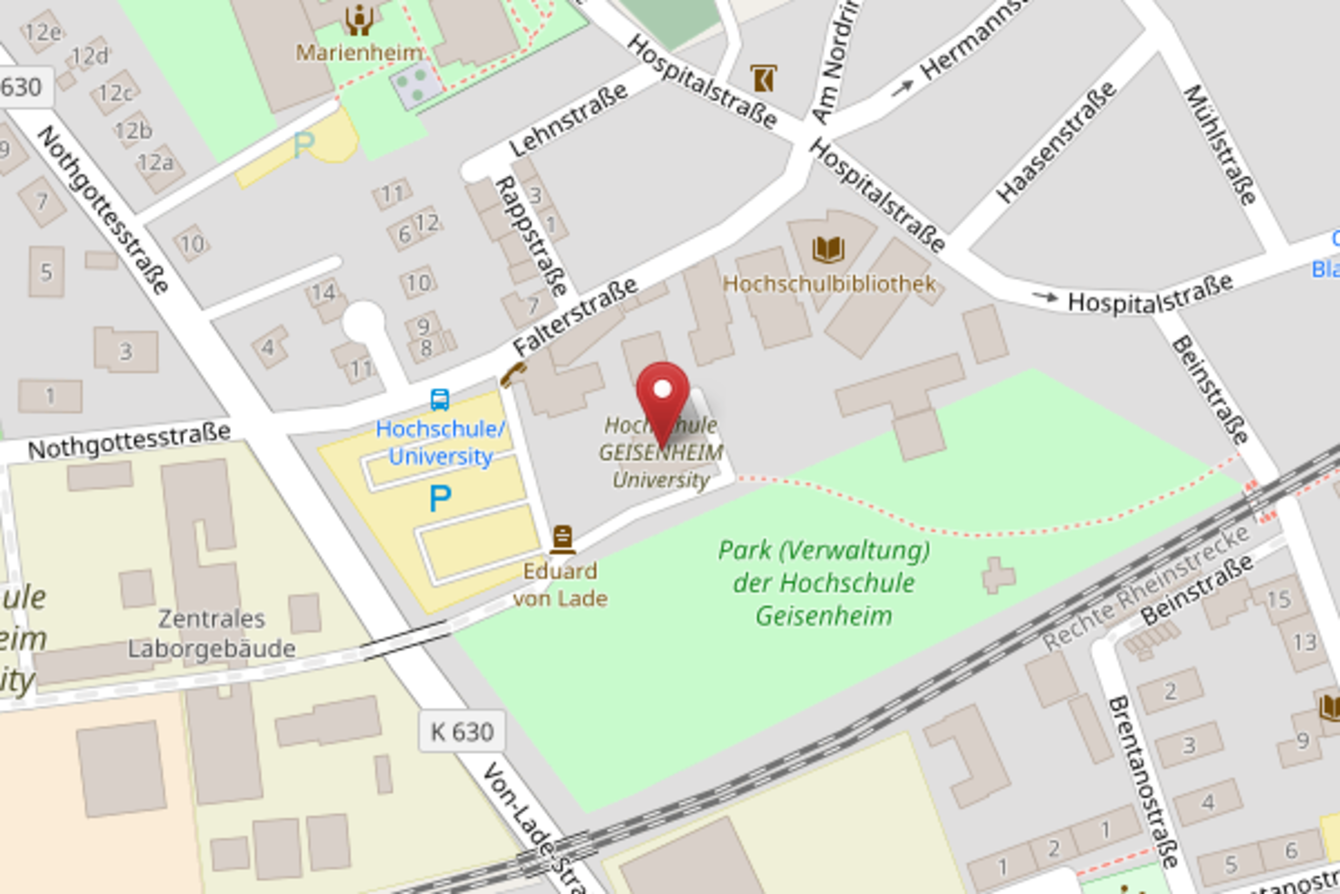HOCHaromatisch - the new herb garden
The campus building is located in the center of the northern campus. In addition to the cafeteria, many conferences and events take place in important rooms. It is therefore important that the green areas of the entrance area have special planting. As a reminiscence of the original herb garden in front of the greenhouses, a herb show garden was created here at the beginning of 2023. It shows over 70 different plant species and their varieties.
Perennial herbs are arranged thematically in the available planting areas. Plants with similar areas of origin, location conditions, and assortments of different genera and species are combined to form a representative planting, the design language of which is based on the architecture of the campus building. The selection consists predominantly of plants from hot, dry regions such as the Mediterranean.
The herb garden was deliberately designed as a mixture of classic, "horticultural" and therefore much more maintenance-intensive herb gardens and the requirements of low-maintenance public green spaces. There are some necessary care procedures here too, but significantly fewer than in a herb garden, which also contains changing one- to two-year-old plants. The clean and balanced planting substrate as well as the mulching pads ensure that the plants are provided with the best possible and long-term care. Interference with the surfaces should be avoided as far as possible.
How can that be, the floor of the herb garden is covered over a large area - with GRAVEL of all things. Everyone is talking about gravel and it is now absolutely taboo. The so-called "gravel gardens" must be banned, federal states enact bans - cities enact statutes. How can it be that a newly created bed commits such a faux pas?
This is primarily due to the fact that the herb garden is not a gravel garden at all. It is a planting with over 70 different plant species sitting and thriving in a sustainable plant bed. At the beginning this may look quite frightening, since the gravel - called "mineral mulch" in the technical jargon - is still so present. Over time, however, the plants will have developed so far that the underground can hardly be seen. So why all the gravel?
Mineral mulch - crushed stone, chippings, gravel, sand - serves as a sustainable protection against evaporation for the plant substrate introduced. The mulch layer covers the soil with a layer thickness of approx. 8 cm and thus prevents significant amounts of water from evaporating through sun, heat and wind. The soil can hold its moisture more strongly and thus make the water available to the plants for longer. At the same time, this is protected against damage to the soil structure, e.g. by drying out or compaction when walking on the surfaces. This in turn means that rainwater can be better absorbed by the ground. Heavy downpours seep more into the green area and do not wash out the soil. This also benefits rainwater management during heavy rain events.
The heat generated by the stone surface is also desirable for the planting. Many plants from the Mediterranean region and from warmer climes grow here, which welcome such soil warmth or even need it in order to be able to grow vigorously. The more vital the plant is, the better it can fulfill any function and also look attractive. In summer, this effect is mitigated by the leaves of the plants, but in winter, heat-loving species are happy about stone surfaces that heat up quickly, so they can survive the local wet winters better.
Warmth-loving insects and small animals can also thrive in such an environment, as there is a wide variety of materials and food sources.
The first and most important difference is that this is a species-rich bed. A gravel garden is an unvegetated area. In rare cases, there are isolated plants or planted tubs in these areas that can shade the ground. But the surface is mostly free and can heat up unhindered. The heat stores up into the night and ensures that the environment in urban areas heats up even more.
In order to suppress weeds - since the layer thicknesses are usually too small to prevent weeds from germinating - a plastic film is often placed between the ground and crushed stone, grit or gravel. Sound easy to care for? - this is unfortunately a fallacy. This usually results in very laborious areas, since "weeds" fly in or penetrate through the fleece and grow strongly on the unrivaled area. The removal is very time-consuming due to the gravel and fleece. A lot of hazardous waste is generated here, since not all weed fleece is made from biodegradable materials, but is constantly being crushed or rubbed off. This is not an attractive habitat for most living creatures and the soil also suffers from impoverishment and littering.
Unlike gravel gardens, a bed covered with mineral mulch can be easier to maintain than traditional beds. However, this requires careful preparation.
Before any kind of mulch is applied to the bed, the existing soil should be as free as possible of unwanted weeds. Annual, light-germinating species are not the problem here, as they no longer germinate under a layer of mulch. Much more important is the thorough removal of the roots of perennial plants and rampant "root weeds" such as couch grass. If this is not possible, or if intensive flight cannot be avoided, mineral mulch should not be used.
To avoid this, soil is removed - especially in urban areas with little "healthy" soil. A plant substrate that is free of weeds and seeds is then applied there. Finally, a layer thickness of at least 6, better 8 cm of mulch is applied to prevent evaporation. The layer thickness of mineral mulches makes it difficult for wild herb seeds to germinate. Seedlings can be removed quickly in organic mulches. Mineral mulches range from sand and grit to lava granules, organic mulches such as bark, green waste compost and wood fibers can be used especially in shadier, woodier beds. These must then be renewed regularly. Each edition has its strengths and weaknesses.
As long as all steps have been carried out properly and the planting material does not bring too much unwanted growth with it, these beds can be very easy to care for. The desired plants have the soil to themselves and can develop magnificently. Evaporation is less and fewer pours are required. But here, too, the caregiver must keep an eye on everything and prevent root weeds from migrating in or too much organic material from falling leaves, for example, otherwise soil will form between the stones and unwanted weeds will germinate there.

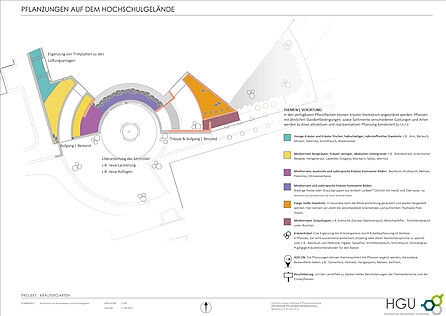
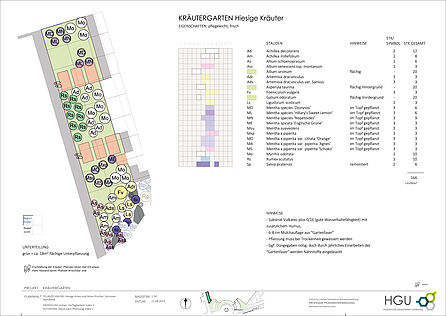

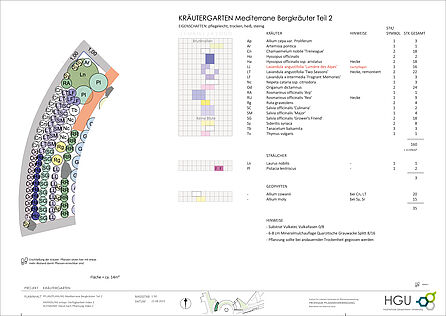
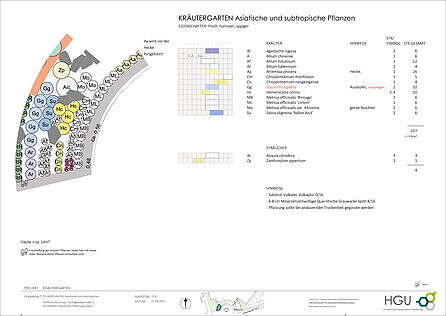

![Mediterrean mountain herbs 1 & 2; M.Faust 2023 [Translate to English:] Mediterrane Pflanzung Blick von Südwest](/fileadmin/_processed_/e/3/csm_MF_KG_Bild_2_d7c3bfb492.jpg)
![Asian & subtropical herbs; M.Faust 2023 [Translate to English:] Asiatische Pflanzung Blick von Südost](/fileadmin/_processed_/0/8/csm_MF_KG_Bild_6_1bb674ee90.jpg)
![Asian & subtropical herbs in summer; M.Faust 2023 [Translate to English:] Asiatische und mediterrane Pflanzung Detail](/fileadmin/_processed_/e/6/csm_MF_KG_Bild_1_angepasst_e63a80e7db.jpg)
![Allium fistulosum; M.Faust 2023 [Translate to English:] Asiatische und mediterrane Pflanzung Detail](/fileadmin/_processed_/c/2/csm_MF_KG_Bild_3_1380b6e9cb.jpg)
![special locations, Thymus & Satureja with stone; M. Faust 2023 [Translate to English:] Sonderstandort Detail](/fileadmin/_processed_/2/f/csm_MF_KG_Bild_4_angepasst_d350cd127b.jpg)
![special location; M. Faust 2023 [Translate to English:] Sonderstandort](/fileadmin/_processed_/2/5/csm_MF_KG_Bild_5_1613d21fb7.jpg)

